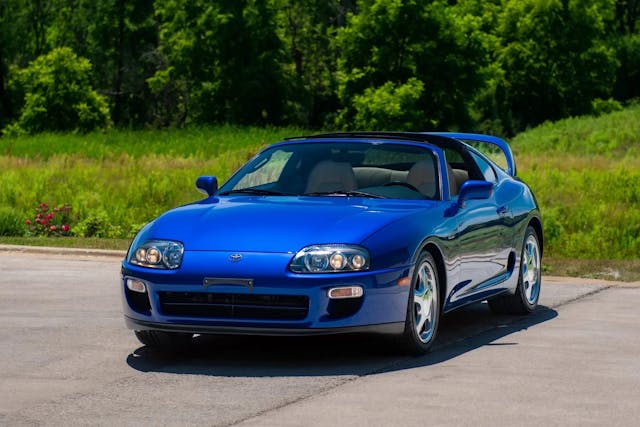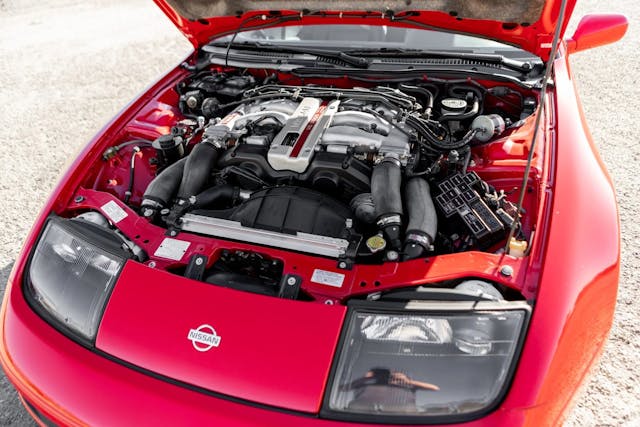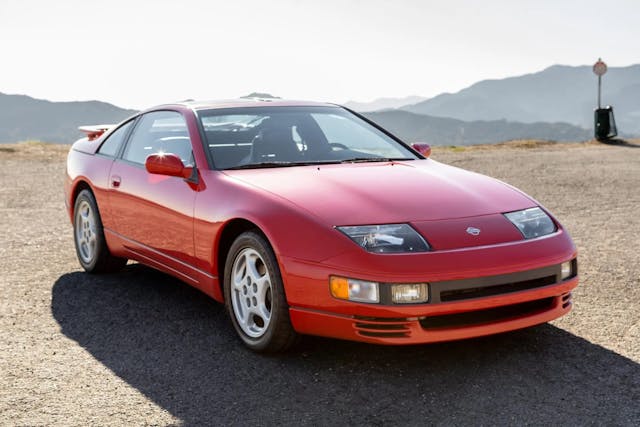Media | Articles
The ’90s Japanese performance-car market is no longer rational
Last week, bidders on Bring a Trailer had an extraordinarily rare crack at a 17,000-mile 1994 Nissan Skyline GT-R V-Spec N1, a car that is considered one of the most desirable Japanese cars ever made, full stop. Internal discussions amongst both the Insider and Valuation teams had this as a no-sale at anything under the $250,000 mark, with estimates reaching beyond $300,000. Bidding stalled out at $141,000.
A sign of a cooling market, perhaps?
Nope. Five days later, a far, far more commonplace 22,000-mile 1994 Nissan 300ZX Twin Turbo sold easily for $140,000.

As if that weren’t nonsensical enough, note that a week prior to that, a 29,000-mile naturally aspirated 1994 Nissan 300ZX in similar condition to the TT changed hands for $21,525. That’s a $60,000 premium paid per turbocharger, or about twice the gap we’d expect to see based on Hagerty Price Guide values. At the same time, the bell rung at $110,000 for a 5000-mile 1993 Mazda RX-7. On the same day as the TT closed, an automatic, targa-topped 1997 Toyota Supra Turbo closed at $235,000.
If you’re looking for us to present charts and data that rationalize why these sorts of sales are happening, no dice. We’re as confused as you. Instead, chalk up these sales as further evidence that the market for 1990s Japanese performance cars is no longer rational.
Marketplace
Buy and sell classics with confidence
Let’s start with that 300ZX. $140,000 paid for a 300ZX Twin Turbo of any condition is overbought by our book, blitzing past our valuation for an example in Hagerty Price Guide #1 (Concours) condition by $65,700. From a spreadsheet standard, it’s certainly not worth almost $120,000 more than the #2 (Excellent) non-turbo 1994 300ZX that sold just two days prior. A carbon-copy of this 300ZX TT with just 1000 more miles sold for a much more reasonable $57,435 back in May. Yes, the market is moving fast right now, but it’s not moving that fast.

The same goes for the Supra. The selling price is some eighty grand more than our price guide’s value for a 1997 Supra Turbo in excellent (#2) condition. Oh, and that valuation is for a manual transmission car—autos typically go for twenty five percent less. We’ll save you the effort of whipping out your calculator and tell you the car sold for double what we’d expect. This car’s rare combination of Royal Sapphire Pearl over Ivory leather does presumably boost this a bit, but not by a factor of two. A week prior to this sale, a one-owner white, automatic 1998 Supra Turbo targa with fewer miles attracted $147,500—still a big price, but one that at least correlates to the market.
These outlier sales are wild—and are starting to make things tricky. While there have been meteoric spikes in areas of the Japanese collector car space—the N1’s 100-percent quarterly boost is a topical place to start—both the Supra and the 300ZX Twin Turbo are established, mature Japanese staples. We shouldn’t be seeing this kind of growth, and we’re not. We don’t think, at least.

Let’s step back to the no-sale Skyline. As far as we can tell, this is the first R32 N1 already imported to the U.S. offered at public auction, the precious few previous public sales on-record occurring mostly either in Japan or Australia. Only 64 V-Spec I N1s were ever made, each a bona-fide homologation special aimed at re-populating the starting grid of the namesake “N1” racing series. It’s lighter, quicker, and impressively honed when compared with the standard production R32 GT-R; as example of its asceticism, each N1 wore a feathery, ultra-thin coat of white paint that scraped an incredible 66 pounds from the final tally.
Short of a 400R, the tiny cluster of N1s produced across the R32, R33, and R34 generations sit at the zenith of the GT-R market, and in-turn near the very apogee of the Japanese collector market as a whole. Our data shows values of standard 1989–1994 R32s are boiling over with an 18 percent rise for our most recent quarterly update to the Hagerty Price Guide. The N1 has increased by a stunning 100 percent. We have first-hand reports of clean ones claiming well over $300,000 off-market, and one N1 is currently fielding offers that approach its $600,000 asking price. As long as a reserve was (smartly) in place, we reckoned Bring a Trailer’s N1 was never going to sell for anything below $200,000 in the current market.
But then, what is the current market? When things are moving so fast, that can be hard to pin down. Consider that the “low-ball” $141,000 high bid would have been perfectly reasonable back in January, when our Price Guide pegged a concours-condition car at $197,000 and an excellent example at $119,000. Turn the clock back to September 2021, and the same money might have been considered generous.

Of course, inexplicable sales and no-sales have always been part of the auctions game. All it takes for a ridiculously high number are two highly motivated bidders.
The turbo 300ZX buyer, “Nirvana,” admits they weren’t going to let this one go after losing the prior concours-grade 300ZX sold back in May. “This was one of my childhood dream cars,” they wrote. “This completes my Japanese collection. Red NSX, red RX-7, red 280ZX, and red 300ZX. I’m not big on Supras…” The RX-7 and Supra had some distinguishing features that might excite a deep-pocketed bidder: rare paint and interior combo for the Toyota and ultra-low miles for the Mazda. The GT-R, for its part, simply could have caught the market at the wrong moment. With such tiny production figures and such a high valuation, the amount of interested collectors moneyed enough to play in this space is sparse.

No individual sale makes or breaks a car’s value—that’s why we’re all about data around here. And if the winning bidders are happy with their new-to-them rides, then we’re happy for them. Yet such outliers call attention to the messiness of the market for Japanese sports cars. After 18 months of wild appreciation, it seems some bidders no longer know (or care) how much is too much.




